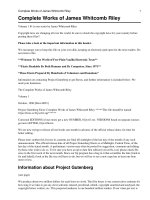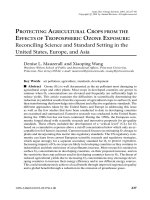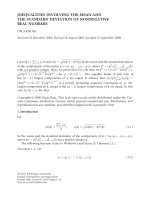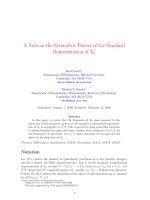Standard edition of the complete psychological works of sigmund freud vol 15
Bạn đang xem bản rút gọn của tài liệu. Xem và tải ngay bản đầy đủ của tài liệu tại đây (12.95 MB, 245 trang )
THE STANDARD EDITION OF
THE COMPLETE PSYCHOLOGICAL WORKS
OF SIGMUND FREUD
VOLUME
XV
•y
' - A
i tt'». '."A-V ^
* I f
,
i
M
THE PRISONER'S DREAM
THE STANDARD EDITION
OF THE COMPLETE PSYCHOLOGICAL WORKS OF
S
I
G
M
U
N
D
F
R
E
U
D
Translatedfrom the German under the General Editorship of
JAMES
STRACHEY
In Collaboration with
ANNA
FREUD
Assisted by
A L I X STRACHEY and ALAN TYSON
VOLUME
XV
(1915-1916)
Introductory Lectures
on
Psycho-Analysis
(PARTS I and II)
LONDON
THE
HOGARTH
PRESS
AND THE INSTITUTE OF PSYCHO-ANALYSIS
PUBLISHED BY
THE HOOARTH PRESS LIMITED
*
CLARKE, IRWIN AND CO. LTD.
TORONTO
( f t
t>
This EditionfirstPublished in
1961
Reprinted 196s, 1964, 1968, 1971, 1973, '975, T978 and J S 5 /
J*
V
ISBN O 7012 OO67 7
All rights reserved. No part of this publication may be reproduced, stored in a retrieval
system, or transmitted, in any form, or by
any means, electronic, mechanical, photocopying, recording or otherwise, without the
prior permission of The Hogarth Press Ltd.
TRANSLATION AND EDITORIAL MATTER
© THE INSTITUTE OF PSYCHO-ANALYSIS
AND ANGELA RICHARDS I961
PRINTED AND BOUND IN GREAT BRITAIN
BY BUTLER AND TANNER LTD, FROME
CONTENTS
VOLUME
FIFTEEN
INTRODUCTORY LECTURES ON PSYCHO-ANALYSIS
(1916-1917[1915-1917])
Editor's Introduction
Preface [1917]
Preface to the Hebrew Translation [1930]
PART I.
Lecture
I
II
III
IV
V
VI
VII
VIII
IX
X
XI
XII
XIII
XIV
XV
XVI
XVII
page 3
9
11
PARAPRAXES (1916[1915])
Introduction
Parapraxes
Parapraxes (continued)
Parapraxes (concluded)
PART II. DREAMS (1916[1915-16])
Difficulties and First Approaches
The Premisses and Technique of Interpretation
The Manifest Content of Dreams and the Latent
Dream-Thoughts
Children's Dreams
The Censorship of Dreams
Symbolism in Dreams
The Dream-Work
Some Analyses of Sample Dreams
The Archaic Features and Infantilism of Dreams
Wish-Fulfilment
Uncertainties and Criticisms
VOLUME SIXTEEN
PART III. GENERAL THEORY OF THE
NEUROSES (1917[1916-17])
Psycho-Analysis and Psychiatry
The Sense of Symptoms
15
25
40
60
83
100
113
126
136
149
170
184
199
213
228
234
257
vi
Lecture
XVIII
XIX
XX
XXI
CONTENTS
Fixation to Traumas—The Unconscious
page 273
Resistance and Repression
286
The Sexual Life of Human Beings
303
The Development of the Libido and the Sexual
Organizations
320
XXII
Some Thoughts on Development and Regression—
Aetiology
339
X X I I I The Paths to the Formation of Symptoms
358
XXIV The Common Neurotic State
378
Anxiety
XXV
392
XXVI The Libido Theory and Narcissism
412
XXVII Transference
431
XXVIII Analytic Therapy
448
BIBLIOGRAPHY AND AUTHOR INDEX
464
LIST OF ABBREVIATIONS
477
INDEX OF PARAPRAXES
478
INDEX OF DREAMS
480
INDEX OF SYMBOLS
481
GENERAL INDEX
483
FRONTISPIECE "The Prisoner's Dream' by Schwind.
(Reproduced by kind permission of the Schack Gallery,
Munich.)
INTRODUCTORY LECTURES
PSYCHO-ANALYSIS
(1916-17[1915-17])
ON
EDITOR'S
INTRODUCTION
VORLESUNGEN ZUR EINFUHRUNG IN DIE
PSYCHOANALYSE
(a)
GERMAN EDITIONS:
1916
Part I (separately), Die Fehlleistungen. Leipzig and
Vienna: Heller.
1916
Part I I (separately), Der Traum. Same publishers.
1917
Part I I I (separately), Allgemeine Neurosenlehre. Same publishers.
1917
The above, three parts in one volume. Same publishers.
Pp. viii + 545.
1918
2nd ed. (With index and inserted list of 40 corrigenda.)
Same publishers. Pp. viii + 553.
1920
3rd ed. (Corrected reprint of above.) Leipzig, Vienna
and Zurich: Internationaler Psychoanalytischer Verlag. Pp. viii + 553.
1922
4th ed. (Corrected reprint of above.) Same publishers.
Pp. viii + 554. (Also Parts I I and I I I separately,
under titles Vorlesungen uber den Traum and Allgemeine
Neurosenlehre.)
1922
Pocket ed. (No index.) Same publishers. Pp. iv
495.
1922
Pocket ed. (2nd ed., corrected and with index.) Same
publishers. Pp. iv + 502.
1924
G.S., 7. Pp. 483.
1926
5th ed. (Reprint of G.S.) I.P.V. Pp. 483.
1926
Pocket ed. (3rd ed.) Same publishers.
1930
Small 8vo. e d . I.P.V. Pp. 501.
1933
(By licence.) Berlin: Kiepenheuer. Pp. 524.
1940
G.W., 11, Pp. 495,
+
4
EDITOR'S INTRODUCTION
(b)
1920
ENGLISH TRANSLATIONS:
A General Introduction to Psychoanalysis
New York: Boni & Liveright. Pp. x + 406. (Tr. unspecified; Foreword G. Stanley Hall.)
Introductory Lectures on Psycho-Analysis
1922
1929
1935
London: Allen & Unwin. Pp. 395. (Tr. Joan Riviere;
without Freud's preface; with preface by Ernest
Jones.)
2nd ed. (revised). Same publishers. Pp. 395.
A General Introduction to Psychoanalysis
New York: Liveright. Pp. 412. (The London ed. under
the title of the old New York one. Tr. Joan Riviere;
with prefaces by Ernest Jones and G. Stanley Hall.
Freud's preface included.)
The present translation is a new one by James Strachey.
This book had a wider circulation than any of Freud's
works, except, perhaps, The Psychopathology of Everyday Life.1 It
is also distinguished by the number of misprints in it. As is
recorded above, 40 were corrected in the second edition; but
there were many more, and a considerable number of slight
variations in the text may be observed in the various editions.
The present translation follows the text of the Gesammelte Werke,
which is in fact identical with that of the Gesammelte Schriften',
and only the more important deviations from earlier versions
have been recorded.
The actual date of publication of the three parts is not clear.
Part I was certainly out before the end of July, 1916, as is
shown by a reference to it in a letter of Freud's to Lou AndreasSalome" ofJuly 27, 1916 (cf. Freud, 1960). I n the same letter he
1
The Lectures were certainly the most translated of any. In Freud's lifetime (apart from English) they appeared in Dutch (1917),French (1922),
Italian (1922), Russian (1922-3), Spanish (1923), Japanese (1928),
Norwegian (1929), Hebrew (1930), Hungarian (1932), Serbo-Croatian
(1933), Chinese (1933), Polish (1935) and Czech (1936). They had probably also appeared by then in Portuguese, Swedish, and later in Arabic.
E D I T O R ' S INTRODUCTON
5
also speaks of Part I I as being on the point of appearing. Part
I I I seems to have been published in May, 1917.
T h e academic year of the University of Vienna fell into two
parts: a winter term (or semester) running from October to
March, and a summer one from April to July. The lectures
printed here were delivered by Freud in two successive winter
terms during the first World War: 1915-16 and 1916-17. 1
The fullest account of the circumstances leading to their publication will be found in the second volume of Ernest Jones's
biography (1955, 245 ff.).
Although, as Freud himself remarked in his preface to the
New introductory Lectures, his membership of the University of
Vienna had only been 'a peripheral one', he had nevertheless,
from the time of his appointment as Privatdozent (University
Lecturer) i n 1885 and as Professor Extraordinarius (Assistant
Professor) in 1902, given many courses of University lectures.
These remained unrecorded, though some accounts of them
may be found—for instance, by Hanns Sachs (1945, 39 ff.) and
Theodor Reik (1942, 19 ff.), as well as by Ernest Jones (1953,
375 ff.). Freud decided that the series beginning in the autumn
of 1915 should be the last, and it was at Otto Rank's suggestion
that he agreed upon their publication. I n his preface to the
New Introductory Lectures which has just been quoted Freud tells
us that the first half of the present, earlier, series 'were improvised, and written out immediately afterwards' and that 'drafts
of the second half were made during the intervening summer
vacation, at Salzburg, and delivered word for word in the
following winter'. He adds that at that time he 'still possessed a
phonographic memory', for, however carefully his lectures
might have been prepared, his actual delivery of them was
invariably extempore 2 and usually without notes. There is
general agreement upon his technique of lecturing: that he was
never rhetorical and that his tone was always one of quiet and
1
The opening lecture of the series was delivered, according to Ernest
Jones, on October 23, 1915, but according to a contemporary notice
(Int. Z- Psychoan., 3, 376) on October 16. It is agreed that they were
given on Saturdays.
1
A single exception to this rule is recorded in the case of his Budapest
Congress paper (1919a); cf. Jones (1953, 375 n).
6
EDITOR'S INTRODUCTION
even intimate conversation. But it must not be supposed from
this that there was anything slovenly or disordered about his
lectures. They almost always had a definite form—a head, body
and tail—and might often give the hearer the impression of
possessing an aesthetic unity.
I t has been said (Reik, 1942, 19) that he disliked lecturing,
but it is difficult to reconcile this, not only with the number of
lectures he delivered in the course of his life, but with the remarkably high proportion of his actually published work which
is in the form of lectures. There is, however, a possible explanation of this inconsistency. Examination shows that among his
publications it is predominantly the expository works that appear
as lectures: for instance, the early lecture on 'The Aetiology of
Hysteria' (1896c), the somewhat later one ' O n Psychotherapy'
(1905a), as well, of course, as the Five Lectures delivered in
America (1910a) and the present series. But beyond this, when,
many years afterwards, he undertook an exposition of the later
developments of his views, he, for no obvious reason, once more
threw them into lecture form and published his New Introductory
Lectures (1933a), though there was never any possibility of their
being delivered as such. Thus lectures as a method of putting
forward his opinions evidently appealed to Freud, but only
subject to a particular condition: he must be in a lively contact
with his real or supposed audience. Readers of the present
volume will discover how constandy Freud retains this contact—how regularly he puts objections into his audience's mouth
and how frequently there are imaginary arguments between
him and his hearers. He in fact carried over this method of
stating his case to some of his works which are not lectures at
all: the whole of The Question of Lay Analysis (1926c) and the
greater part of The Future of an Illusion (1927c) take the form of
dialogues between the author and a critical listener. Contrary,
perhaps, to some mistaken notions, Freud was entirely opposed
to laying down his views in an authoritarian and dogmatic
fashion: T shall not tell it you', he says to his audience at one
point below (p. 431), 'but shall insist on your discovering it for
yourselves.' Objections were not to be shouted down but
brought into the open and examined. And this, after all, was
no more than an extension of an essential feature of the technique of psycho-analysis itself.
EDITOR'S INTRODUCTION
7
The Introductory Lectures may justly be regarded as a stocktaking of Freud's views and the position of psycho-analysis at
the time of the first World War. T h e secessions of Adler and
J u n g were already past history, the concept of narcissism was
some years old, the epoch-making case history of the 'Wolf
M a n ' had been written (with the exception of two passages) a
year before the lectures began, though it was not published till
later. So, too, the great series of 'metapsychological' papers on
fundamental theory had been finished a few months earlier,
though only three had been pubUshed. (Two more of them
appeared soon after the lectures, but the remaining seven
disappeared without leaving a trace.) These latter activities,
and no doubt the production of the lectures as well, had been
facilitated by the slackening in Freud's clinical work imposed
by war conditions. A watershed had apparently been reached
and the time seemed to have come for a halt. But in fact fresh
creative ideas were in preparation which were to see the light
in Beyond the Pleasure Principle (1920g), Group Psychology (1921c)
and The Ego and the Id (19236). Indeed, the line must not be
drawn too sharply. Already, for instance, hints may be detected
of the notion of the 'compulsion to repeat' (p. 274), and the
beginnings of the analysis of the ego are quite apparent (pp. 422
and 428), while the difficulties over the multiple senses of the
term 'unconscious' (see p. 22 In. 1) are paving the way towards
the new structural account of the mind.
I n his preface to these lectures Freud speaks a little depreciatively of the lack of novelty in their contents. But no one,
however well-read in psycho-analytic literature, need feel afraid
of being bored by them or could fail to find plenty in them that
is not to be found elsewhere. The discussions on anxiety (Lecture X X V ) and on primal phantasies (Lecture X X I V ) , which
Freud himself singles out in his preface as fresh material, are
not the only ones he might have mentioned. The review of
symbolism in Lecture X is probably his most complete. Nowhere does he give such a clear summary of the formation of
dreams as in the last pages of Lecture X I V . There are no more
understanding commentaries on the perversions than those in
Lectures X X and X X I . Finally, there is no rival to the analysis of the process of psycho-analytic therapy given in the last
lecture of all. And even where the subjects would seem to be
8
EDITOR'S INTRODUCTION
well-worn, such as the mechanism of parapraxes and of dreams,
they are approached from unexpected directions and throw
fresh illumination on what might have seemed depressingly
familiar ground. The Introductory Lectures have thoroughly
deserved their popularity. 1
1
From their very nature these lectures touch upon a large variety
of subjects, into some of which Freud (as he himself remarks in the last
paragraph of the final lecture) has been unable to enter very deeply.
Many readers, and especially students who find in this work their first
approach to psycho-analysis, are likely to come upon some point about
which they would wish to learn more. An attempt has accordingly been
made in the footnotes of this edition to give particularly generous
references to others of Freud's writings in which the topic in the text
is dealt with at greater length.
PREFACE^
[1917]
WHAT I am here offering the public as an 'Introduction to
Psycho-Analysis' 2 is not designed to compete in any way with
such general accounts of this field of knowledge as are already
in existence, e.g. those of Hitschmann (1913), Pfister (1913),
Kaplan (1914), Regis and Hesnard (1914) and Meijer (1915).
This volume is a faithful reproduction of the lectures which I
delivered [at the University] during the two Winter Terms
1915/16 and 1916/17 before an audience of doctors and laymen
of both sexes.
Any peculiarities of this book which may strike its readers
are accounted for by the conditions in which it originated. I t
was not possible in my presentation to preserve the unruffled
calm of a scientific treatise. O n the contrary, the lecturer had
to make it his business to prevent his audience's attention from
lapsing during a session lasting for almost two hours. The
necessities of the moment often made it impossible to avoid
repetitions in treating some particular subject—it might emerge
once, for instance, in connection with dream-interpretation and
then again later on in connection with the problems of the
neuroses. As a result, too, of the way in which the material was
arranged, some important topics (the unconscious, for instance)
could not be exhaustively treated at a single point, but had
to be taken up repeatedly and then dropped again until a
fresh opportunity arose for adding some further information
about it.
Those who are familiar with psycho-analytic literature will
find little in this 'Introduction' that could not have been known
to them already from other much more detailed publications.
Nevertheless, the need for rounding-off and summarizing the
subject-matter has compelled the author at certain points (the
1
[This Preface was omitted from the 1922 English translation and its
re-issues.]
1
[A literal translation of the German title of the book would be
'Lectures to Serve as an Introduction to Psycho-Analysis'.]
9
10
PREFACE
aetiology of anxiety and hysterical phantasies) to bring forward
material that he has hitherto held back.
FREUD
VIENNA, Spring 1917
PREFACE
HEBREW
TO
THE
TRANSLATION
1
[1930]
THESE lectures were delivered in 1916 and 1917; they gave a
fairly accurate account of the position of the young science at
that period and they contained more than their title indicated.
They provided not only an introduction to psycho-analysis but
covered the greater part of its subject-matter. This is naturally
no longer true. Advances have in the meantime taken place in
its theory and important additions have been made to it, such
as the division of the personality into an ego, a super-ego and
an id, a radical alteration in the theory of the instincts, and
discoveries concerning the origin of conscience and the sense of
guilt. These lectures have thus become to a large extent incomplete; it is in fact only now that they have become truly
'introductory'. But in another sense, even to-day they have not
been superseded or become obsolete. W h a t they contain is still
believed and taught, apart from a few modifications, in psychoanalytic training schools.
Readers of Hebrew and especially young people eager for
knowledge are presented in this volume with psycho-analysis
clothed in the ancient language which has been awakened to a
new life by the will of the Jewish people. T h e author can well
picture the problem which this has set its translator. Nor need
he suppress his doubt whether Moses and the Prophets would
have found these Hebrew lectures intelligible. But he begs
their descendants (among whom he himself is numbered), for
whom this book is designed, not to react too quickly to their
first impulses of criticism and dislike by rejecting it. Psychoanalysis brings forward so much that is new, and among it so
much that contradicts traditional opinions and wounds deeplyrooted feeUngs, that it is bound at first to provoke denial. A
1
[This preface was first published in German in G.S., 12 (1934),
383-4, and reprinted in G.W., 16 (1950), 274-5. It is here translated
into English for the first time by James Strachey. The Hebrew translation was published by the Verlag Stybel in Jerusalem in 1930.]
S.F. xv—B
11
12
PREFACE
reader who suspends his judgement and allows psycho-analysis
as a whole to make its impression on him will perhaps become
open to a conviction that even this undesired novelty is worth
knowing and is indispensable for anyone who wishes to understand the mind and human Ufe.
VIENNA, December 1930
PART
I
PARAPRAXES
(1916
[1915])









